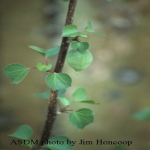
 You may not have noticed them; they are visually inconspicuous; just a small leafless plant most of the year. Among the many strange plants of the desert are two called “limberbush” or, sometimes in Spanish, “sangre de drago.” The Spanish name refers to the sap of the plants, which starts out clear, but dries to a deep red. If you get any on your clothes, it will look like a blood stain and it won’t wash out. The English name, “limberbush” is given due to the fact that the branches are extremely pliable and contain natural latex rubber.
You may not have noticed them; they are visually inconspicuous; just a small leafless plant most of the year. Among the many strange plants of the desert are two called “limberbush” or, sometimes in Spanish, “sangre de drago.” The Spanish name refers to the sap of the plants, which starts out clear, but dries to a deep red. If you get any on your clothes, it will look like a blood stain and it won’t wash out. The English name, “limberbush” is given due to the fact that the branches are extremely pliable and contain natural latex rubber.
The photos in this article are of Jatropha cardiophylla which reaches its northern limit just a few miles north of Tucson. The other limberbush is Jatropha cuneata which inhabits the Yuma area and points south. Both species occur below elevations of 4,000 feet. See more photos of both species at the Arizona-Sonora Desert Museum digital library here.
Cardiophylla gets up to three feet high and Cuneata can get up to six feet high. Both have reddish-brown bark on the branches which are semi-succulent. The bulk of the plant is underground with extensive roots that give rise to the branches.
For most of the year, the plants are leafless. Just prior to the monsoon, the humidity in the air will cause the plants to produce buds which turn into bright green, heart-shaped leaves when the rains come. Flowers are tiny, yellowish-white bells.
The O’odham and Seri people use limberbush extensively in basketry. The branches are roasted, split and soaked through an elaborate process. They also obtained red dye from the roots.
Limberbush is extremely astringent. The native peoples used the sap or a poultice of mashed branches to soothe toothache, burns, bites, and stings.
A related plant, Jatropha curcas was being investigated by the University of Arizona as a possible biofuel because the seeds contain up to 37% oil.
Be observant on your walks around Tucson; see if you can spot the “blood of the dragon.”
For information on other desert plants see:
Saguaro Cactus Icon of the Sonoran Desert
Yuccas provide food, fiber, and soap
The Jojoba bush and its valuable oil
Mesquite trees provide food, fuel, medicine, and more

